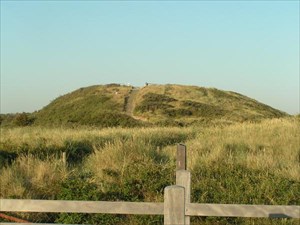EarthCache: De Hoge Hil - Reloaded

The coast dunes of the Netherlands originate from the Holocene period.
As is the case with the sea clay scenery, the wind, water and salt loving
plants play an important part in the creation of the scenery.
The dunes in the Netherlands are on the upper side of the banks.
They consist of sand from the bottom of the sea or rivers.
The question that rises is: how is it possible that sand from the bottom of the sea ends up on top of the dunes.
The answer is that this primarily happens because of the tidal flows and the wave movements.
The salt-loving plants hold together the small dunes and stop the new sand grains blowing away. This means the dunes get higher and higher. After the rise, marrams settle, which is a type of grass highly suitable for holding sand together and which is resistant to dryness. All small dunes eventually form a closed dune row. This dune row can develop into a sea strip: a solid seawall which is high enough to dam water during a storm flood. A sea strip can grow to more than 20 metres high and can either settle towards an existent sea strip or a little further away from it. The latter can for instance happen when a surf ridge gets so high that it remains uncovered during ebb tide. The sea water trapped between both sea strips may become fresh, and eventually a layer of peat or clay will originate. This new surface between the dunes is called a primary dune valley. The origin of old dunes The oldest surviving bank with dunes of the Netherlands was created about 5,000 years ago. Until the beginning of the era many new banks with dunes originated. These dunes gradually raised because the sea level kept on rising. The dunes that originated in this period, are called old dunes. The old dunes have a height of 10 metres. Primary dune valleys are situated between the rows of old dunes. The origin of young dunes About 500 years before Christ, the sea started to rise again. A very strong western wind caused storm floods, which wiped away large pieces of the coast. The old dunes were partly ruined at many places, and completely destroyed at others. For this reason, there are no old dunes along the south-west and northern coasts of the Netherlands. A lot of sand was made free through of coastal erosion. This sand formed new young dunes in the period from 1200 until 1600 years after Christ. In North and South Holland, these young dunes are situated on top of the old dunes. The older the dunes, the further inland they are situated. Moreover, young dunes are much higher and have more relief than old dunes: the young dunes can grow to over 50 metres high.
Near Zoutelande you will find the highest dunes of the Netherland,
an very nice overview about the dunes of Zeelande you will find at the "Hoge Hill" near Domburg at
N51 33.793 E3 29.444
To log this Earthcache take a Photo of you at the Top of "Hoge Hill" and have a look to the Stones
there. Please send me an eMail with the Answers of the following Questions :
01. Your estimation of the height of the dune
02. How long is the largest Stone?
03. What kind of stones are it?
